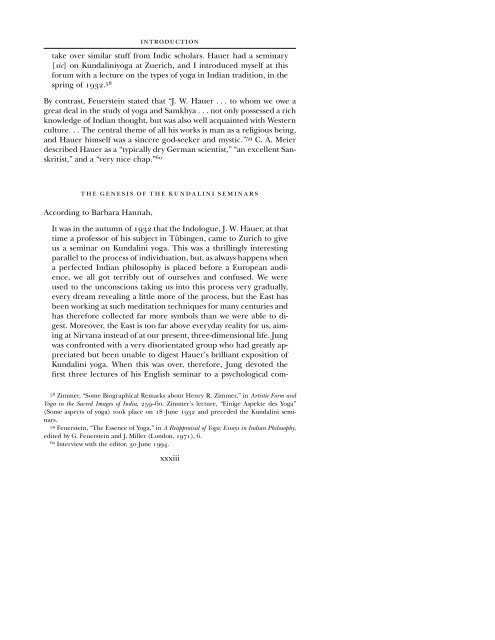CG JUNG - Countryside Anarchist
CG JUNG - Countryside Anarchist
CG JUNG - Countryside Anarchist
Create successful ePaper yourself
Turn your PDF publications into a flip-book with our unique Google optimized e-Paper software.
INTRODUCTION<br />
take over similar stuff from Indic scholars. Hauer had a seminary<br />
[sic] on Kundaliniyoga at Zuerich, and I introduced myself at this<br />
forum with a lecture on the types of yoga in Indian tradition, in the<br />
spring of 1932. 58<br />
By contrast, Feuerstein stated that “J. W. Hauer . . . to whom we owe a<br />
great deal in the study of yoga and Samkhya . . . not only possessed a rich<br />
knowledge of Indian thought, but was also well acquainted with Western<br />
culture. . . The central theme of all his works is man as a religious being,<br />
and Hauer himself was a sincere god-seeker and mystic.” 59 C. A. Meier<br />
described Hauer as a “typically dry German scientist,” “an excellent Sanskritist,”<br />
and a “very nice chap.” 60<br />
THE GENESIS OF THE KUNDALINI SEMINARS<br />
According to Barbara Hannah,<br />
It was in the autumn of 1932 that the Indologue, J. W. Hauer, at that<br />
time a professor of his subject in Tübingen, came to Zurich to give<br />
us a seminar on Kundalini yoga. This was a thrillingly interesting<br />
parallel to the process of individuation, but, as always happens when<br />
a perfected Indian philosophy is placed before a European audience,<br />
we all got terribly out of ourselves and confused. We were<br />
used to the unconscious taking us into this process very gradually,<br />
every dream revealing a little more of the process, but the East has<br />
been working at such meditation techniques for many centuries and<br />
has therefore collected far more symbols than we were able to digest.<br />
Moreover, the East is too far above everyday reality for us, aiming<br />
at Nirvana instead of at our present, three-dimensional life. Jung<br />
was confronted with a very disorientated group who had greatly appreciated<br />
but been unable to digest Hauer’s brilliant exposition of<br />
Kundalini yoga. When this was over, therefore, Jung devoted the<br />
first three lectures of his English seminar to a psychological com-<br />
58 Zimmer, “Some Biographical Remarks about Henry R. Zimmer,” in Artistic Form and<br />
Yoga in the Sacred Images of India, 259–60. Zimmer’s lecture, “Einige Aspekte des Yoga”<br />
(Some aspects of yoga) took place on 18 June 1932 and preceded the Kundalini seminars.<br />
59 Feuerstein, “The Essence of Yoga,” in A Reappraisal of Yoga: Essays in Indian Philosophy,<br />
edited by G. Feuerstein and J. Miller (London, 1971), 6.<br />
60 Interview with the editor, 30 June 1994.<br />
xxxiii


